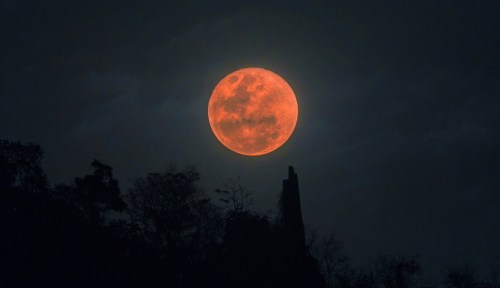Our editors independently select these products. Making a purchase through our links may earn Well+Good a commission
What Is a Lunar Eclipse? Here Are the Different Types, What They Mean, and When They Occur
Learn what a lunar eclipse really is, the different types that can occur, how often they happen, and what they mean for us on Earth.

If you find the night sky fascinating, eclipse season is probably one of your favorite times of year. Seeing the moon shift into new positions as it crosses paths with the Earth can be a thrilling experience. Night sky watchers can get excited about seeing the full moon turn darker in the sky (or even a blood-red hue) during a lunar eclipse, which is when the moon passes fully or partially into Earth’s shadow—as will happen during the penumbral lunar eclipse in Libra on March 25, 2024.
Experts in This Article
astrologer and founder of Jupiter Jewel
clairvoyant, astrologer, tarot card reader, and co-host of the So Divine! podcast
astrologer and author of Moon Signs: Unlock Your Inner Luminary Power
Though lunar eclipses may be more commonly visible by a larger swath of people on Earth than solar eclipses—when the moon passes between the sun and Earth—they’re astrologically significant in their own way. According to astrologer Alexandria Lettman, founder of spiritual wellness platform Jupiter Jewel, lunar eclipses are “like an end of a chapter and a breakthrough that brings closure, release, and celebration.” As such, these intense lunations can mark both an ending and a beginning of a new and fated path.
What causes a lunar eclipse?
Lunar eclipses happen when the moon passes into Earth’s shadow during the full moon phase, as it aligns on the same horizontal plane as the Earth’s orbit (called the ecliptic). Depending on exactly how the sun, Earth, and moon are lined up at the time of an eclipse, the Earth’s shadow obscures the moon to various degrees, causing different types of eclipses (more on those below).
The invisible points in the sky where the moon is located when this lineup occurs are called the lunar nodes, one of which is in the northern hemisphere (the north node) and the other of which is in the southern hemisphere (the south node).
Solar eclipses similarly occur when the moon crosses the same horizontal plane as the Earth, but instead of being in the Earth’s shadow, it’s located directly between the sun and the Earth, partially or totally obscuring the sun’s light from our view.
Lunar eclipses typically last a few hours, with totality (or the period during which the moon is fully shadowed by Earth) lasting anywhere from 30 minutes to a half hour. Whereas, solar eclipses are much shorter (due to the small size of the moon in comparison to the Earth), with the period of totality or annularity—when the sun is completely blocked by the moon or during which a “ring of light” can be seen around the moon, respectively—lasting just a couple seconds to a few minutes.
How often do lunar eclipses happen?
Lunar eclipses happen between two and five times a year. While there is a full moon every month, not every full moon is also a lunar eclipse. That’s because the moon’s orbit doesn’t typically fall on the same horizontal plane as the Earth’s orbit around the sun; only when the Earth is between the sun and the moon, and the moon is aligned horizontally with the other two will the moon fall in Earth’s shadow, creating a lunar eclipse.
Types of lunar eclipses
Total lunar eclipse

A total lunar eclipse happens when the moon passes into the umbra, or the inner part of Earth’s shadow where the only sunlight reflected on the moon is passing through Earth’s atmosphere first. Colors with shorter wavelengths are scattered by the Earth’s atmosphere, leaving behind longer wavelength colors, like red and orange, which can give the moon a red tinge (hence the nickname of “blood moon”). Total lunar eclipses are rare compared to the other types.
Upcoming total lunar eclipses visible in North America: March 13, 2025
Partial lunar eclipse

When the sun, moon, and the Earth align imperfectly and not entirely in a straight line, it’s a partial lunar eclipse. Earth’s shadow doesn’t completely cover the moon.
Upcoming partial lunar eclipses visible in North America: September 18, 2024
Penumbral lunar eclipse

The toughest type of lunar eclipse to see, a penumbral lunar eclipse happens when the moon moves only through the outer part of Earth’s shadow, the penumbra (and never crosses either partially or totally into the umbra). The penumbra is a lighter part of the shadow (falling out of the reaches of the red wavelengths), meaning the moon will just appear a slightly darker color than usual.
Upcoming penumbral lunar eclipses visible in North America: March 25, 2024
Meaning of a lunar eclipse in astrology
In astrology, lunar eclipses signal major internal shakeups because the moon rules over our inner emotions and feelings. Lunar eclipses are “essentially super dramatic, super powerful, and super karmic full moons, which bring about both closure and the ripe possibility of new beginnings,” says Lettman. In this way, lunar eclipses can have “long shadows” for how the energy and vibe of the upcoming year will look, according to astrologer Narayana Montúfar, author of Moon Signs: Unlock Your Inner Luminary Power.
“Eclipses, in general, are wild cards because you don’t know how they’re going to pan out.”—Narayana Montúfar, astrologer
Unlike a typical full moon, a lunar eclipses holds the promise and potential of both the beginning and ending of a story, not just a culmination. “You might think that a full moon lunar eclipse is an ending, but for certain people, they are beginnings… Eclipses, in general, are wild cards because you don’t know how they’re going to pan out,” says Montúfar. It might feel like there is something unknown pulling you in a new direction, so it’s best to just ride the wave.
As noted above, lunar eclipses happen at or near one of the lunar nodes, which are always located in a pair of opposite zodiac signs, shifting into new signs about every 18 months. The zodiac sign in which any given lunar eclipse occurs will color its energetic vibe. Because the lunar eclipse on October 28 occurs near the north node, in the sign of Taurus, and it’s the last eclipse to occur in Taurus before the node shifts into Aries, “this is the end of a story that began [last] January,” says Montúfar.
In this case, we can expect to experience fated changes around such Taurean topics as material security and sensuality—in other words, “what sustains you and what you need to survive,” meaning your finances, resources, and relationships, says Montúfar.
Frequently Asked Questions About Lunar Eclipses
Which zodiac signs are most affected by lunar eclipses?
People who have their sun, moon, or rising sign in the same sign as a given solar eclipse will feel it most intensely. In the case of the upcoming lunar eclipse on October 28, Taurus will be especially affected by the culmination vibes.
The signs that share a modality with the sign of a particular eclipse can expect a pronounced impact, too. “We look at where the eclipse is falling to see which signs are affected, so for this upcoming eclipse, all the fixed signs will feel it a lot,” says Montúfar. This means that in addition to Taurus, those who have their sun, moon, or rising signs in Scorpio, Leo, and Aquarius will particularly sense the ecliptic shifts this go-round.
Because eclipses have to do with the movement of the moon, Cancer, the emotional water sign that’s ruled by the moon, is also bound to feel the energy of any eclipses mightily, adds Montúfar. If a lunar eclipse falls on your lunar return (aka when the moon returns to the place it was in when you were born), you can expect an especially powerful reset, too.
What should you not do during a lunar eclipse?
Unlike a typical full moon, a lunar eclipse isn’t the time to manifest, according to both Montúfar and Lettman; instead, it’s best to just get out of the way, and let what’s supposed to happen run its course. This means not trying to bring your own desires and wants into the world as it’s happening. “Our instinct is to resist or change the direction of where things are going, so do not interfere with the universe’s plan,” says Lettman. “Don’t do manifestation and don’t try to control outcomes.”
The vibes are intense during eclipse season, and lunar eclipses aren’t the time to make impulsive or rash decisions—especially those based in anxiety or fear—because so much is already coming to a head. Montúfar advises waiting until after the lunar eclipse to make major decisions because everyone’s bound to feel shaken up and unsettled. “During those two to four weeks that we have eclipses, we’re feeling tired, low energy, nervous, and anxious,” she says.
What should you do during lunar eclipses?
To get through a lunar eclipse, remember to take care of your emotional and physical needs. It’s a time to take it easy and be patient with yourself. Montúfar recommends prioritizing sleep and connecting with the body through mindful movement like yoga. Emotionally, she also recommends steering clear of arguments and fights because people are bound to be more amped up and anxious—don’t take the bait.
All of this said, it’s important not to fear or stress over the changes afoot during an eclipse, says Montúfar. Instead of worrying about all that’s to come, spend time grounding yourself in a spiritual or introspective practice. According to Montúfar, lunar eclipses “can be a very magical time if we connect with our spirituality,” and make time for meditation, a lunar eclipse ritual like cord cutting, journaling, pulling tarot or oracle cards, or reciting soothing personal mantras.
Why does the moon turn red during a total lunar eclipse?
In short? Because the Earth’s atmosphere (which is filled with particles and dust) scatters different wavelengths of light. According to NASA, “colors with shorter wavelengths—the blues and violets—scatter more easily than colors with longer wavelengths, like red and orange. Because these longer wavelengths make it through Earth’s atmosphere, and the shorter wavelengths have scattered away, the moon appears orange or reddish during a total lunar eclipse.”
The more particles and dust are in the Earth’s atmosphere during the time of a total lunar eclipse, the redder the moon may appear.
Are lunar eclipses good or bad omens?
According to Lettman, lunar eclipses “aren’t good or bad—they just are,” meaning they don’t have a particular connotation of luck or despair attached to them. They’re simply the wrap-up of previous events and the beginning of new ones—which can certainly feel unsettling in the moment, but isn’t so much a negative thing (or a positive thing) as it is a cosmic course correction. “The things that happen under a lunar eclipse can feel so painful and uncomfortable, but in six months, we could find ourselves thankful that they happened,” she adds.
Is it safe to look at a lunar eclipse?
Unlike a solar eclipse, it’s perfectly safe to view a lunar eclipse with your bare eyes; no special protective eye equipment or considerations are necessary. (You’ll need your protective eclipse glasses for the next total solar eclipse in Aries on April 8, 2024.)
Sign Up for Our Daily Newsletter
Get all the latest in wellness, trends, food, fitness, beauty, and more delivered right to your inbox.
Got it, you've been added to our email list.






